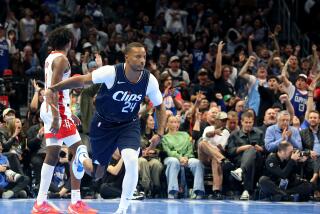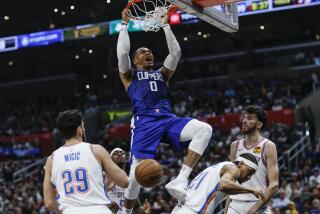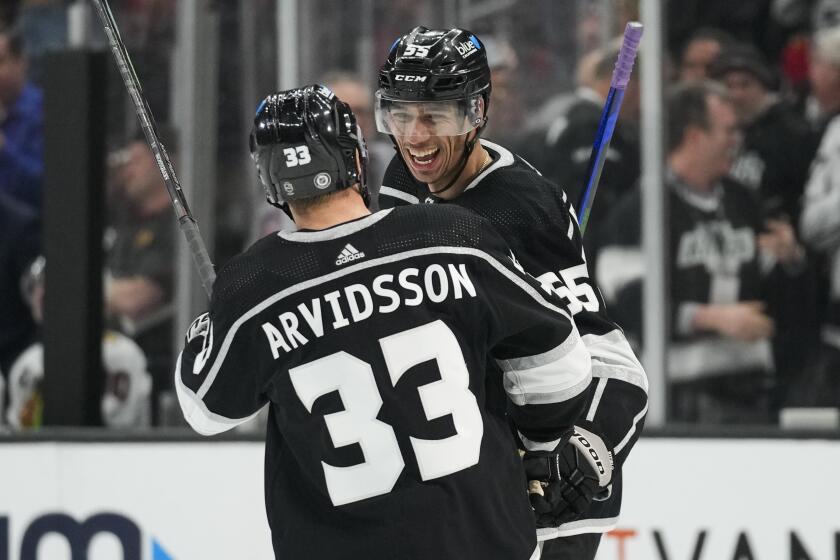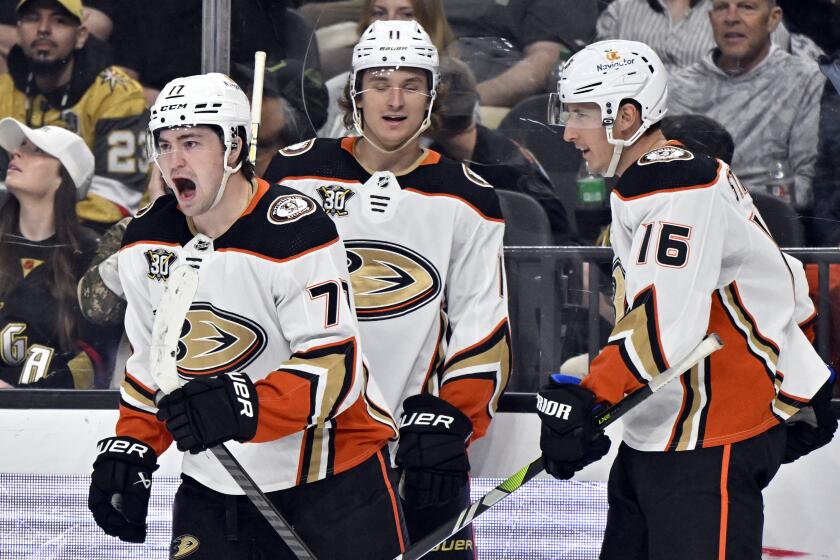Jamal Crawford’s crossover move makes him a dribble threat
It’s the move that twists ankles, crushes spirits and confounds even the sharpest of defensive minds.
Jamal Crawford’s crossover dribble is a straight-up pain to those who try to stop it.
He can fake to his left and go to his right. Dribble behind his back or between his legs. Or hesitate before accelerating toward the basket.
Often, the veteran Clippers guard will combine multiple moves in a blur of activity that resembles something out of a Harlem Globetrotters routine.
Don’t bother guessing which move he will go to next. Not even Crawford has any idea.
“When I have the ball,” he said, “I don’t know exactly what I’m going to do, so there’s no way the guy on me knows what I’m going to do.”
Crawford is always reading and reacting to the defense, his signature move helping him become the NBA’s second-leading bench scorer this season behind New York’s J.R. Smith and a front-runner for the league’s sixth man of the year award. It’s also one of the reasons he has scored 50 points or more in a game with three NBA teams.
The move has spawned the Twitter handle @JCrossover and a legion of nicknames from his teammates. Chauncey Billups calls Crawford “The Mechanic” because he’s always fixing people up with his ability to create space for jumpers or drives toward the basket. Grant Hill dubs his array of moves “The Barbecue Pit” because Crawford is constantly cooking his defender.
“To say it’s extremely impressive is an understatement,” said Hall of Fame point guard Isiah Thomas, one of the inspirations for Crawford’s crossover dribble. “You want to find a better word in your vocabulary to express how extraordinary his ballhandling skills are in terms of being able to get anywhere out on the floor that he needs to get to and also to create a shot. His creativity in terms of handling the basketball is off the charts.”
Crawford, 32, is hardly the only NBA player who has mastered the crossover. Clippers point guard Chris Paul has several wicked moves, as do the Brooklyn Nets’ Deron Williams and Chicago Bulls’ Derrick Rose.
Of course, none of them are 6-foot-5 shooting guards, as Crawford is.
“When you can handle the ball like a point guard and play against ‘two’ guards, it’s special,” Oklahoma City Thunder Coach Scott Brooks said. “What he does, you know it’s coming and you know which way he’s going and you always get lulled to sleep.”
Crawford’s crossover is largely a function of quickness, deception and crafty ballhandling. Ambidextrous since infancy, he can fake out defenders going to his left or his right, though he has found that teams often shade him as if he prefers going to his right.
He constantly scans the players behind his primary defender, anticipating how a play might develop once he gets past his man. He needs only a smidgen of space for a jumper or a drive to the basket. If the defense converges on him, Crawford can pass to an open teammate.
“He’s got a lot of tricks,” said Oklahoma City guard Thabo Sefolosha, who was victimized on one of Crawford’s crossovers in the third quarter Tuesday night at Staples Center. Crawford froze Sefolosha with a moment’s hesitation before breaking into a between-the-legs dribble that allowed him to drive for a pull-up jumper.
Many of Crawford’s best crossovers are documented on YouTube clips accompanied by breathless comments. His favorite is one from five years ago in which Ray Allen steps up to guard him on the perimeter. Crawford dribbles between his legs, behind his back and then behind his back again, with the final move forcing Allen to stumble helplessly to the court.
“He had sat there on the first two moves,” Crawford said while watching the clip on a computer at the Clippers’ practice facility, “so I knew I was going to pull it back because he was still with me on the initial crossover. That’s the thing about the crossover: Sometimes you have to do a move just to set him up for another move.”
Crawford completed the play by finding then-teammate Stephen Jackson open in the corner for a three-pointer. He was grateful Jackson made the shot because nothing irks Crawford more than what he calls “a million-dollar move followed by a 10-cent finish.”
More often than not, it’s the move preceding the finish that wows fans while leaving defenders with the occasional sprained ankle to go with their bruised egos.
“Why’d you do me like that?” is a refrain Crawford has repeatedly heard since he unveiled his crossover at Seattle’s Rainier Beach High in the late 1990s before going on to one season at Michigan.
The ballhandling skills that would make Crawford a league-wide sensation were cultivated nearly from the crib. His parents first placed a basketball in his hands at age 2, not realizing it would accompany him everywhere.
Growing up, Crawford would dribble to the mall. He would dribble to the movies. If anyone stepped in his way, Crawford would make a move and keep going, not saying a word.
When his older sister once picked him up at the airport, Crawford had a ball in one hand and a box of basketball cards in the other. “Some kids carry a security blanket,” said Lori Brown, who doted on a sibling 12 years her junior. “He had his basketball.”
It wasn’t long before Crawford tried to emulate NBA crossover legends Thomas, Tim Hardaway and Allen Iverson, whose moves mesmerized him. Crawford even wore Thomas’ No. 11 a few years into his pro career. One thing that always separated Crawford from his heroes was his height.
Thomas would go on to call Crawford a taller version of himself, only better.
“I can only hope that I looked that good doing the things he does out on the floor,” said Thomas, who was the New York Knicks’ coach and director of basketball operations while Crawford played there from 2004-08.
You might be surprised to know that Crawford never practices his crossover — or his dribbling, for that matter.
“It sounds crazy, right?” he said. “But I’m being dead honest. I just read what the defender does. And I think that’s why it looks the way it does; it’s different than anybody else’s because it’s not like I hit a cone or hit a spot and then did a move. It’s along the lines of what the defender is doing.”
Crawford takes it from there, freeing himself to leave more disappointment in his wake.
twitter.com/latbbolch
More to Read
Get our high school sports newsletter
Prep Rally is devoted to the SoCal high school sports experience, bringing you scores, stories and a behind-the-scenes look at what makes prep sports so popular.
You may occasionally receive promotional content from the Los Angeles Times.







